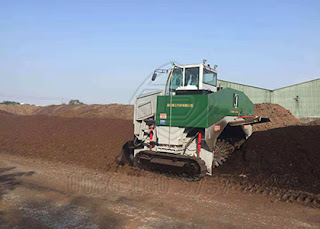What should you pay more attention during composting?
Organic waste can be converted into organic fertilizer by composting. So as to continue great oxygen consuming breakdown of manure, the heap needs 4 parts working in relative equalization:
Carbon: This is now and then alluded to as "darker matter" and it's normally dry. Carbon can be provided to the fertilizer by dried leaves, garden clippings, paper, straw, etc. These materials give the vitality to the microbial activity in the heap, and as the microorganisms separate the carbon matter, warm is delivered.
Nitrogen: High nitrogen fixings to the compost heap are frequently alluded to as "green matter." These are the wet natural segments like kitchen scraps, excrement, and spent plant matter from the garden. The nitrogen materials enable the organisms to imitate in extraordinary numbers, which helps the breakdown of the entire heap.
 |
| Windrow composting equipment |
Oxygen: Without an enduring supply of oxygen, the deterioration abandons high-impact to anaerobic, which delivers inadequately crumbled, stinky outcomes. Oxygen is utilized by organisms to oxidize the carbon in the heap, and is basic for legitimate decay. So you should stir and turn the organic waste to adjust oxygen content.
Water: The microorganisms require some dampness – a lot of water will forestall great air circulation of the heap, and will result in stinky anaerobic activity. Too little dampness will keep the breakdown of the heap.
As microorganisms do their work in the manure heap, they create a considerable amount of warmth. This can result in loss of dampness through vanishing, and loss of oxygen through the warming procedure. So the heap should be tended to routinely for it to work proficiently. For the most part, it's a smart thought to exchange layers of green (nitrogen) matter and dark colored (carbon) matter in the heap. For example, each time you include a basin of kitchen scraps, you should finish it off with a bunch of straw, some folded paper, or some other darker issue.
 |
| Self propelled compost turner |
As the highest point of the heap becomes heavier, the base layers will squish together, which lessens the stream of oxygen, and urges dampness to gather. Turning the manure (taking material from the base and putting it to finish everything) is one approach to empower predictable breakdown. Devices (like garden forks) ought to be utilized to pull material from the base of the heap up towards the surface. As you do as such, you cut the heap, which energizes great air circulation.
The last outcome, obviously, is very much spoiled manure soil, or humus. This is dull darker because of the high carbon content, and very light in surface. In very much handled manure, there ought to be no extensive bits of flawless material. Humus is as separated as it will ever get. At the point when humus is added to cultivate soil, it really nourishes the living beings in the dirt, including night crawlers, which thus, advantage the dirt structure and the supplements accessible to become solid, sound, gainful plants. In addition, you can adopt an aerobic compost bin to compost these organic waste.
 |
| Aerobic compost bin |


Comments
Post a Comment